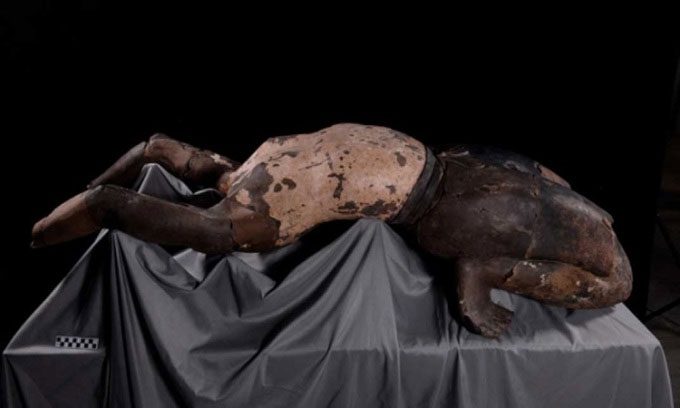Amidst 8,000 battle-ready warrior statues, a clay figure in a circus performance posture reveals another side of Emperor Qin Shi Huang’s life.

The statue simulating an acrobat in the tomb of Emperor Qin Shi Huang. (Photo: Xinhua)
The clay statue is lying on its back with knees bent, feet spread apart, hips resting on the heels, and hands supporting the ground, was discovered in the tomb of Emperor Qin Shi Huang. China celebrated Natural and Cultural Heritage Day on June 11, 2022. On this day, the Museum of the Qin Shi Huang Mausoleum Site in Xi’an, Shaanxi Province, China, was highlighted. Designed to oversee the mausoleum, it is the largest museum in China, housing the richest collection of artifacts, including the Terracotta Army.
On March 29, 1974, archaeologists discovered the first samples in the army of over 8,000 life-sized terracotta warriors guarding the burial site of China’s first emperor, Qin Shi Huang (221 – 207 BC), the first king to unify the country. Each terracotta warrior is depicted either standing or sitting. This makes the “lying” statue particularly unusual. According to the research team’s report, the statue lying on its back was buried in the Baixiyong pit, located in the southeastern area of the mausoleum and covering an area of about 700 m2. According to the museum, this statue is distinct from the terracotta warriors and officials in other burial pits due to its “unique posture.”
Measuring 154 cm in length and weighing 101 kg, the statue lying on its back bears fingerprints on its abdomen, created by the artisan who crafted the terracotta figure. In addition to the fingerprints, archaeologists also found traces of lacquer on the statue’s arms. All these marks help scientists gain a better understanding of the methods and processes used by ancient artisans working for the emperor.
The museum concludes that the statue may depict an acrobat performing in the palace. Recently, researchers also discovered several circus performer statues, 15 musician figures, and 13 waterfowl in this excavation area. Emperor Qin Shi Huang was buried with everything he needed for the afterlife. Most famously, there is the Terracotta Army with hundreds of archers and horses as large as real horses. However, the emperor also needed entertainment, which is why there are statues of circus performers in the tomb.





















































